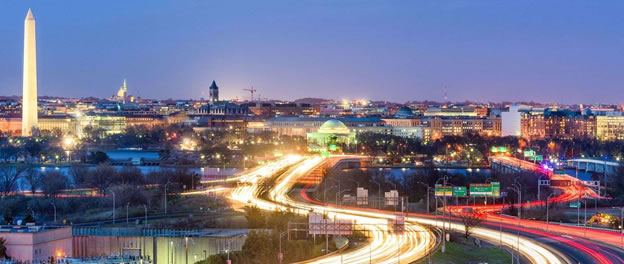
District of Columbia Smart Street Lighting Project is the nation’s largest urban streetlight modernization P3 project. The project will convert the city’s more than 75,000 street and alley lights to energy-efficient LED technology with remote monitoring and control capabilities.
Source: Credit to Plenary Group
| Project Name | Washington DC Street Light Modernization P3 |
|---|---|
| Location | District of Columbia (DC) |
| Project Sponsor / Borrower | Plenary Infrastructure DC (PIDC) consortium, the Office of Public-Private Partnerships (OP3) & District Department of Transportation (DDOT) |
| Program Areas |
|
| Value Capture Techniques | N/A |
| Mode | Resilient Infrastructure: Smart Street Lighting |
| Description | The DC Smart Street Lighting project is the first urban Public-Private Partnerships (P3s) street lighting project in North America. The District is upgrading all of the related infrastructure including the light heads and poles, converting the District’s network of more than 75,000 streetlights into energy-efficient LED bulbs and also upgrading and expanding its Wi-Fi infrastructure and network. The Wi-Fi component of the project will add 239 wireless access points across the District, expanding broadband availability into areas of need within the District. The District will also install a remote monitoring and control system for the network that will allow the city to operate its streetlights much like a smart-home, with the ability to monitor and turn on and off lights from miles away. The DC Smart Street Lighting project is the first urban P3 street lighting project in North America. The District is upgrading all of the related infrastructure including the light heads and poles, converting the District’s network of more than 75,000 streetlights into energy-efficient LED bulbs and also upgrading and expanding its Wi-Fi infrastructure and network. The Wi-Fi component of the project will add 239 wireless access points across the District, expanding broadband availability into areas of need within the District. The District will also install a remote monitoring and control system for the network that will allow the city to operate its streetlights much like a smart-home, with the ability to monitor and turn on and off lights from miles away. The tax-exempt, private activity bonds included a green bond designation and received a private activity bond allocation from the U.S. Department of Transportation, thereby reducing the costs of the financing for the project. The proceeds of the bonds were loaned by the District of Columbia to Plenary Infrastructure DC LLC, which will use the proceeds to complete the streetlight project, pursuant to a long-term P3 project agreement that Plenary entered into with the District. In addition to being an innovative public infrastructure tax-exempt bond financing, the bonds were designated as Green Bonds, since the project is expected to reduce energy consumption by more than 50% and eliminate 38,000 tons of greenhouse gas emissions each year by switching to energy efficient LED lights. Considered the nation’s largest urban streetlight modernization P3 project, the $309 million DC Smart Street Lighting Project will be the District’s first public-private partnership. The project will convert the city’s more than 75,000 street and alley lights to energy-efficient LED technology with remote monitoring and control capabilities. This modern infrastructure will reduce the lights’ energy usage by more than 50 percent, eliminating 38,000 tons of greenhouse gas emissions each year and will extend Wi-Fi coverage in traditionally underserved neighborhoods. Alongside the efficient lighting technologies, the project will install smart city technology components, including a remote monitoring and control system and wireless access points to help solve inconsistent outage reporting. By delivering widescale Wi-Fi coverage, the DC Smart Street Lighting Project will help close the digital divide and advance D.C.’s progress toward its goal of citywide broadband access. The project will convert the city’s more than 75,000 street and alley lights to energy-efficient LED technology with remote monitoring and control capabilities. This modern infrastructure will reduce the lights’ energy usage by more than 50 percent, eliminating 38,000 tons of greenhouse gas emissions each year and will extend Wi-Fi coverage in traditionally underserved neighborhoods. Alongside the efficient lighting technologies, the project will install smart city technology components, including a remote monitoring and control system and wireless access points to help solve inconsistent outage reporting. By delivering widescale Wi-Fi coverage, the DC Smart Street Lighting Project will help close the digital divide and advance D.C.’s progress toward its goal of citywide broadband access. The project includes replacing ~75,000 street and alley lights with energy-efficient LEDs, including those that shine on “Welcome to Washington, D.C.” entrance signs, certain bike paths, underpass, and tunnel lights. The District has more than 75,000 lights installed on our streets, alleys and other public spaces. The lights use a variety of inefficient bulb technologies, including incandescent and high-pressure sodium. The District is seeking a private partner to retrofit the lights with more energy-efficient light-emitting diodes (LED), install a remote monitoring and control system, and repair and maintain the fixtures under a long-term performance-based contract. This project will also incorporate smart city technologies, installing wireless access points across the District, improving the DC-NET public WiFi program. The Smart Street Lighting project includes an upgrade to the District’s entire streetlight network, which consists of approximately 75,000 primarily street and alley lights, as well as select overhead guide signs, internal and external lighting for approximately 30 “Welcome to Washington, DC” signs, and navigation, underpass, bike trail and tunnel lights. The 15-year agreement between the District and PIDC (the consortium that won the tender) includes a two-year design and construction period, followed by a 13-year O&M term. Members of the PIDC consortium are: Plenary Americas US Investment V, Kiewit DC Lighting Investors, and Phoenix Infrastructure Group Investments (equity), Engie Services US (DB contractor), Engie Services, Inc. (asset management contractor), and VHB Metro DC, LLC (lead designer). The Mayor’s FY 2020-2025 budget for capital improvement projects includes USD 76.2m in funding for the project through 2025. The project is the first public-private partnership carried out in Washington, D.C. The District of Columbia approved a $309 million, 15-year contract with Plenary Infrastructure DC(PIDC) to convert the District’s streetlights to energy-efficient LED technology earlier this month. PIDCwill finance the project costs to allow the District to upgrade within two years. The District will pay PIDCback over the course of 15 years, minus any performance-based deductions. The contract structure allows the District to quickly reap the project benefits and improvements without needing all of the capital upfront, according to a press release by the DDOT. |
| Cost | $ 309 million |
| Funding Sources | $159.695 million, Capital Market
$150.80 million, Equity |
| Project Delivery / Contract Method | DBFOM, 15-year Availability based with District of Columbia (Washington, D.C.) |
| Private Partner | Plenary Americas as the lead developer and equity partner.
|
| Project Advisors / Consultants | Washington DC Office of Public-Private Partnerships
|
| Lenders | Wells Fargo & TD Securities |
| Duration / Status | 15-year Availability Payment Based |
| Financial Status / Financial Performance |
|
| Innovations |
|
| Related Links / Articles | |
| Contacts | District of Columbia: Plenary Americas: |

Urban streetlight modernization project in Washington D.C.
Source: Credit to Plenary Group